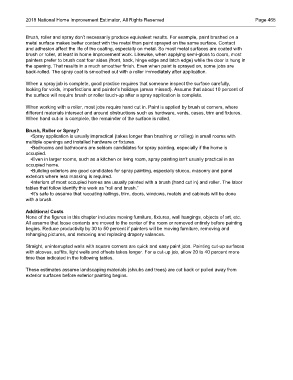Page 586 - 2018 National Home Improvement
P. 586
2018 National Home Improvement Estimator, All Rights Reserved Page 465
Brush, roller and spray don’t necessarily produce equivalent results. For example, paint brushed on a
metal surface makes better contact with the metal than paint sprayed on the same surface. Contact
and adhesion affect the life of the coating, especially on metal. So most metal surfaces are coated with
brush or roller, at least in home improvement work. Likewise, when applying semi-gloss to doors, most
painters prefer to brush coat four sides (front, back, hinge edge and latch edge) while the door is hung in
the opening. That results in a much smoother finish. Even when paint is sprayed on, some jobs are
back-rolled. The spray coat is smoothed out with a roller immediately after application.
When a spray job is complete, good practice requires that someone inspect the surface carefully,
looking for voids, imperfections and painter’s holidays (areas missed). Assume that about 10 percent of
the surface will require brush or roller touch-up after a spray application is complete.
When working with a roller, most jobs require hand cut in. Paint is applied by brush at corners, where
different materials intersect and around obstructions such as hardware, vents, cases, trim and fixtures.
When hand cut-in is complete, the remainder of the surface is rolled.
Brush, Roller or Spray?
•Spray application is usually impractical (takes longer than brushing or rolling) in small rooms with
multiple openings and installed hardware or fixtures.
•Bedrooms and bathrooms are seldom candidates for spray painting, especially if the home is
occupied.
•Even in larger rooms, such as a kitchen or living room, spray painting isn’t usually practical in an
occupied home.
•Building exteriors are good candidates for spray painting, especially stucco, masonry and panel
exteriors where less masking is required.
•Interiors of most occupied homes are usually painted with a brush (hand cut in) and roller. The labor
tables that follow identify this work as “roll and brush.”
•It’s safe to assume that recoating railings, trim, doors, windows, metals and cabinets will be done
with a brush.
Additional Costs
None of the figures in this chapter includes moving furniture, fixtures, wall hangings, objects of art, etc.
All assume that loose contents are moved to the center of the room or removed entirely before painting
begins. Reduce productivity by 30 to 50 percent if painters will be moving furniture, removing and
rehanging pictures, and removing and replacing drapery valances.
Straight, uninterrupted walls with square corners are quick and easy paint jobs. Painting cut-up surfaces
with alcoves, soffits, light wells and offsets takes longer. For a cut-up job, allow 20 to 40 percent more
time than indicated in the following tables.
These estimates assume landscaping materials (shrubs and trees) are cut back or pulled away from
exterior surfaces before exterior painting begins.

